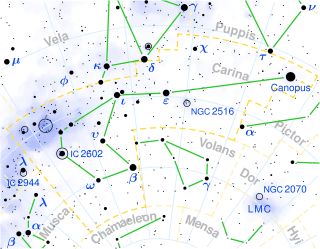Upsilon Carinae
Upsilon Carinae, Latinized from υ Carinae, is a double star in the southern constellation of Carina. It is part of the Diamond Cross asterism in southern Carina. The Upsilon Carinae system has a combined apparent magnitude of +2.97[2] and is approximately 1,400 light years (440 parsecs) from Earth.[1]
 | |
| Observation data Epoch J2000 Equinox J2000 | |
|---|---|
| Constellation | Carina |
| Right ascension | 09h 47m 06.12170s[1] |
| Declination | –65° 04′ 19.2267″[1] |
| Apparent magnitude (V) | 2.97[2] (+3.08/+6.25[3]) |
| Characteristics | |
| Spectral type | A8 Ib + B7 III[4] |
| U−B color index | +0.13[2] |
| B−V color index | +0.27[2] |
| Astrometry | |
| Radial velocity (Rv) | +14[4] km/s |
| Proper motion (μ) | RA: –11.51[1] mas/yr Dec.: +4.71[1] mas/yr |
| Parallax (π) | 2.27 ± 0.28[1] mas |
| Distance | approx. 1,400 ly (approx. 440 pc) |
| Absolute magnitude (MV) | −5.26[5] |
| Details | |
| υ Car A | |
| Mass | 13[4] M☉ |
| Surface gravity (log g) | 1.1 ± 0.3[4] cgs |
| Temperature | 7,600 ± 350[4] K |
| Age | 12[6] Myr |
| υ Car B | |
| Mass | 8[4] M☉ |
| Surface gravity (log g) | 3.3 ± 0.1[4] cgs |
| Temperature | 23,000 ± 1600[4] K |
| Other designations | |
υ Car, CP−64°1084, HIP 48002[7] | |
| A: HD 85124, HR 3891, SAO 250696 | |
| B: HD 85123, HR 3890, SAO 250695 | |
| Database references | |
| SIMBAD | system |
| A | |
| B | |
In Chinese, 海石 (Hǎi Dàn), meaning Sea Rock, refers to an asterism consisting of υ Carinae, ε Carinae, ι Carinae, HD 83183 and HD 84810.[8] Consequently, υ Carinae itself is known as 海石五 (Hǎi Dàn wǔ, English: the Fifth Star of Sea Rock.)[9]
The primary component, υ Carinae A, has a stellar classification of A8 Ib, making it a supergiant star that has exhausted the hydrogen at its core and evolved away from its brief main sequence lifetime as an O9 V star.[4] With an apparent magnitude of +3.08,[3] it has an effective temperature of about 7,600 K,[4] giving it a white hue. The companion, υ Carinae B, is a giant star with a classification of B7 III,[3] although Mandrini and Niemela (1986) suggested it may be a subgiant star with a classification of B4–5 IV.[4] The outer envelope of this star has an effective temperature of around 23,000 K, resulting in the blue-white hue of a B-type star.
The two stars have an angular separation of 5.030 arcseconds. As a binary star system, they would have an estimated orbital period of at least 19,500 years and a present-day separation of around 2,000 Astronomical Units.[4] This system is roughly 12 million years old.[6]
In the next 7500 years, the south Celestial pole will pass close to this stars and Iota Carinae (8100 CE).[10]
References
- van Leeuwen, F. (November 2007), "Validation of the new Hipparcos reduction", Astronomy and Astrophysics, 474 (2): 653–664, arXiv:0708.1752, Bibcode:2007A&A...474..653V, doi:10.1051/0004-6361:20078357
- Nicolet, B. (1978). "Photoelectric photometric Catalogue of homogeneous measurements in the UBV System". Astronomy and Astrophysics Supplement Series. 34: 1–49. Bibcode:1978A&AS...34....1N.
- Eggleton, P. P.; Tokovinin, A. A. (September 2008), "A catalogue of multiplicity among bright stellar systems", Monthly Notices of the Royal Astronomical Society, 389 (2): 869–879, arXiv:0806.2878, Bibcode:2008MNRAS.389..869E, doi:10.1111/j.1365-2966.2008.13596.x
- Samedov, Z. A. (1988), "On the visual binary υ Car and the chemical composition of its brighter component", Izvestiya Krymskoj Astronomicheskoj Observatorii, 79: 57–63, Bibcode:1988IzKry..79...57S
- Anderson, E.; Francis, Ch. (2012), "XHIP: An extended hipparcos compilation", Astronomy Letters, 38 (5): 331, arXiv:1108.4971, Bibcode:2012AstL...38..331A, doi:10.1134/S1063773712050015.
- Mandrini, C. H.; Niemela, V. S. (November 1986), "On the visual binary Upsilon Carinae", Monthly Notices of the Royal Astronomical Society, 223: 79–85, Bibcode:1986MNRAS.223...79M, doi:10.1093/mnras/223.1.79
- "CCDM J09471-6504AB -- Double or multiple star". SIMBAD. Centre de Données astronomiques de Strasbourg. Retrieved 2012-01-26.
- (in Chinese) 中國星座神話, written by 陳久金. Published by 台灣書房出版有限公司, 2005, ISBN 978-986-7332-25-7.
- (in Chinese) AEEA (Activities of Exhibition and Education in Astronomy) 天文教育資訊網 2006 年 7 月 28 日
- http://moonkmft.co.uk/Precession.html